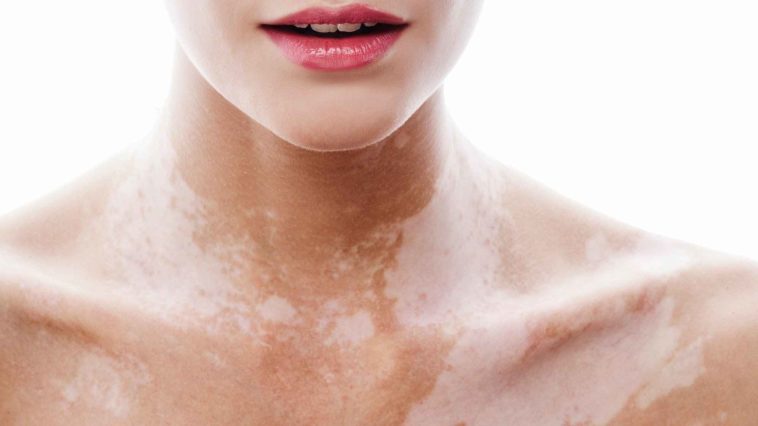While seeking treatment for vitiligo you might have often come across a term – Leucoderma. At times, an interesting question passing your mind could be “what is the difference between vitiligo and leucoderma” as many people (including your doctor) may use vitiligo and leucoderma interchangeably. To empower you with some knowledge (so that you can help a fellow vitiligo fighter understand the difference), let’s understand vitiligo and leucoderma one by one.
What is Vitiligo?
Vitiligo is a long-term skin condition that causes the loss of pigmentation. As a result, white patches appear and grow on the different part of the body. These patches (usually of pale skin color in many cases) become white over the period of time and typically have sharp margins. They often start on areas of skin that are exposed to the sun and typically affect both sides of the body. Depending on the progress, the patches may enter the mouth and nose and may leave hair color to grow white with the skin. Unlike Albinism, people with vitiligo are born with normal pigmentation in their skin. But, as the melanocytes die over time, unpigmented skin appears.
The exact cause of vitiligo is unknown. However, it is closely linked to genetic susceptibility as risk factors for the condition include a family history of the same condition or other autoimmune diseases (such as hyperthyroidism, alopecia areata, and pernicious anemia). So far, all these factors have not been proven to cause vitiligo.
Vitiligo can be classified into two types: segmental and non-segmental. Most cases are non-segmental. In this type, vitiligo affects both sides of the body and the affected area typically expands with time. On the other hand, in segmental cases, the affected area of the skin usually does not expand with time. About 10% of all cases are segmental while about 90% remain non-segmental. A tissue biopsy can help a dermatologist confirm the right diagnosis.
About 1% of the world’s population is affected by vitiligo. While some geographies have higher rates, males and females are equally affected. About half experience the disorder before the age of 20 while most of the people develop it before the age of 40. The disorder is more noticeable in people with dark skin.
Even though vitiligo is not contagious, it may result in psychological stress. If stigmatized for their condition, vitiligo fighters may experience depression, anxiety, and other mood disorders.
What is Leucoderma?
Leucoderma is the de-pigmentation of the skin, characterized by the localization or ultimate destruction of melanocytes. It is seen that leucoderma spots often start after a scratch, a cut or afterburn. This scar formation results in a gradual development of a white patch. The complete loss of melanocyte after the accident or due to allergy can lead to leucoderma. Leucoderma is often, although incorrectly, used interchangeably with the term vitiligo.
Just like vitiligo, what causes leucoderma is unknown. It is speculated that leucoderma may be caused by congenital abnormalities like Tuberous sclerosis, Partial albinism, Piebaldism, and Waardenburg syndrome. While some firmly believe that it may be caused by mental stress too. Therefore avoiding undue psychological stress can even assist an individual to prevent leucoderma.
In cases of extensive leucoderma, the option to de-pigment the unaffected skin with topical drugs takes about a year to complete. Applying certain steroid hormone creams to the affected skin could facilitate re-pigmentation if the sufferer begins using them in the early stage of leucoderma.
Just like vitiligo, leucoderma is not contagious and life-threatening. But, it can potentially alter a person’s life. The disorder may affect a person’s self-esteem. As a result, individuals with Leukoderma may not want to go out in public. Risk of developing depression associated with self-image is always present in most of the cases.
Turmeric and mustard oil paste, a mixture of margosa leaves and honey juice, ginger juice, tamarind seed paste, goosefoot vegetable juice, pomegranate powder and black gram paste are often considered as home remedies to fight with leucoderma.
The difference between vitiligo and leucoderma
Vitiligo and leucoderma are both characterized by extensive white patches over the skin and share many similar symptoms. Due to similar characteristics, some scientists even suggest that vitiligo is a form of leucoderma. So far, no scientific evidence can support so.
Although both vitiligo and leucoderma have different onset symptoms, the line of treatment for both remains the same. The treatment for both skin disorders focuses on pigmentation as well as immunity improvement. This can make it even more difficult to distinguish the dissimilarity between vitiligo and leucoderma. To make things less confusing, we are breaking the noticeable differences between vitiligo and leucoderma into bullet points.
- In vitiligo, the sufferer experiences on-going loss of pigmentation while in case of leucoderma, the ultimate loss of pigmentation is observed.
- Leucoderma strictly occurs following a physical trauma (such as accidental cuts, exposure to the harmful chemical at workplace, burns, and ulcers). On the other hand, vitiligo is mainly triggered by autoimmune conditions, hormonal changes, recurrent episodes of Jaundice or typhoid fever, acute emotional trauma, and prolonged antibiotic treatments. It is believed that, at times, the immune system mistakenly destroys the melanocytes (the cells responsible for pigmentation) in the skin. Many researchers firmly believe that the melanocytes destroy themselves. Some even think that the intake of insecticide/pesticide treated green vegetable, sunburn, emotional distress, heavy immunosuppressant treatment, odd food combinations, regular junk food intake and negligence in hygiene can cause vitiligo.
- Vitiligo commonly involves the areas that are vastly exposed to the sun (such as the face, neck, and hands). While leucoderma does not follow such rules. It starts spreading from the cut and nucleus of the scar.
- The appearance of patches on the skin caused by vitiligo can be improved with certain medications to impart even skin tone. In case of severe leucoderma, a patient is advised to de-pigment the unaffected skin with topical drugs to render the skin an even color. Monobenzone, Mequinol, or Hydroquinone may be used to render the skin an even color. People who go through this procedure must avoid severe sunburn and melanomas.
- The characteristic white patches in leucoderma are closely bounded on the skin compared to vitiligo.
- In many vitiligo cases, patches are milky-white on the skin. In Leukoderma, they are mostly white.
We just got started on the informational blogs. To keep up with the emerging treatment options, self-help and community forum, follow us on social media.

